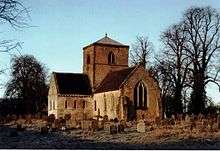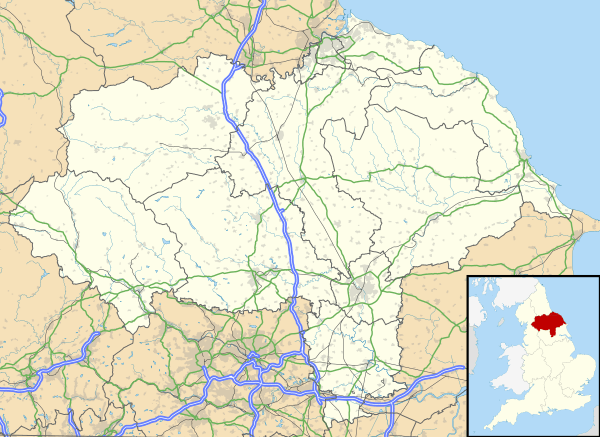Bossall
Bossall is a village in the Ryedale district of North Yorkshire, England. The Church of St Botolph was built in the 12th century with later alterations and is a Grade I listed building.[1] In 1823 it was recorded that there were only three houses and a population of 31, increasing to 76 by 1842, and that archaeological evidence showed that the village was previously much larger.[2][3] It is thought to have been devastated by the Black Death in 1349.[4]
From the early 1300s until the 1420s the manor was held by Paulinus de Bossall and his descendants, after which time it was owned by the Redman or Redmayne family from whom it was later passed by marriage to the Thwaites. In the 1620s it was sold to William Belt. It was around this time that the Grade II listed Bossall Hall was built. Although Sir Robert Belt was dispossessed following the English Civil War, the family continued to hold the manor until the late 1880s.[5][6][7]
Church of St Boltoph

The current church, dedicated to St Botolph, dates from around 1180,[8] though as many as three earlier churches may have occupied the site. One of these is thought to have been built by the late 7th century bishop Bosa of York, after whom it is said the village is named.[4] The church is cruciform and approximately 94 feet (29 m) in length. The transepts, nave and part of the tower are original, but the chancel was rebuilt in the 13th century and alterations were later made to the upper part of the tower. Monuments include a brass figure commemorating Robert Constable, a former chancellor of Dunelm, who died in the 1540s, and several memorials to members of the Belt family.[1][6] The Borthwick Institute holds copies of the parish records which date to the early 17th century.[9]
References
- Historic England. "Church of St Botolph (1315746)". National Heritage List for England. Retrieved 9 October 2016.
- Baines, Edward (1823). "History, directory & gazetteer of the county of York... (Vol. II - East and North Ridings)". Leeds: Edward Baines at the Leeds Mercury office. p. 416. Retrieved 9 October 2016.
- Lawton, George; Ducarel, Andrew Coltee (1842). Collectio Rerum Ecclesiasticarum de Diœcesi Eboracensi... J. G. and F. Rivington, 1842. p. 424. Retrieved 14 October 2016.
- Nixon, Mark D. The Grass Really Was Greener. Lulu.com. pp. 16–17. ISBN 9781329244061. Retrieved 14 October 2016.
- Farrer, William; Clay, Charles Travis (2013). Early Yorkshire Charters: Volume 9, The Stuteville Fee. Cambridge University Press. p. 176. ISBN 9781108058322. Retrieved 14 October 2016.
- William Page (ed.). "'Parishes: Bossall', in A History of the County of York North Riding: Volume 2 (London, 1923)". British History Online. pp. 91–98. Retrieved 14 October 2016.
- Historic England. "Bossall Hall (1149644)". National Heritage List for England. Retrieved 14 October 2016.
- "St Boltoph, Bossall". The Church of England. Retrieved 14 October 2016.
- "Parish Records of Bossall: Finding Aid" (PDF). University of York. Retrieved 14 October 2016.
